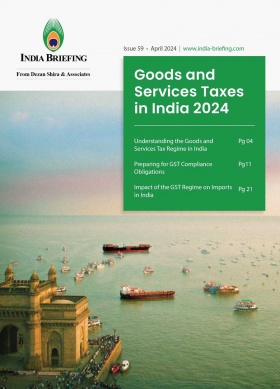Customs Duty in India: Rate Changes Under Union Budget 2024 to Boost Local Manufacturing
India has made changes to its import duty rates on specific items in a move aimed at enhancing its local manufacturing. In the Union Budget 2024-25 announcement, finance minister Nirmala Sitharaman proposed reducing or removing customs duties on items such as gold, silver, mobile phones, chargers, medicines, medical equipment, critical minerals, and inputs for the leather and textiles industries.
Sitharaman also stated that a comprehensive review of the customs duty rate structure will be undertaken over the next six months to rationalize and simplify it for ease of trade, removal of duty inversion, and reduction of disputes.
One may note that for sectors such as chemicals and telecom equipment, customs duties have been increased or exemptions have been withdrawn to encourage domestic production.
Revised custom duty rates
Electronics industry
Basic customs duty (BCD) has been reduced on mobile phones, printed circuit board assembly (PCBAs), and chargers to 15 percent from the previous rate of 20 percent.
Similarly, in terms of precious metals and jewelry, duties on gold and silver are reduced from 15 percent to 6 percent, and on platinum from 15.5 percent to 6.4 percent, making these metals more affordable and boosting sales.
Exemptions for oxygen-free copper used in resistor manufacturing and specific parts for connector production have been extended, enhancing electronics value addition. For raw materials, BCD on ferro nickel and blister copper, essential for steel and copper production, has been removed.
|
Customs Duties Reductions on Goods |
||
|
Particulars |
Old rate |
Revised rate (as of July 24, 2024) |
|
Mobile phone, mobile PCBA and chargers |
20% |
Basic customs duty reduced to 15% |
|
Gold and silver |
15% |
Customs duty reduced to 6% |
|
Gold and silver dore |
14.35% |
5.35% |
|
Platinum |
15.4% |
Customs duty reduced to 6.4% |
|
Broodstock, polychaete worms, shrimp and fish feed |
10%, 30%, and 15% respectively |
Basic customs duty reduced to 5% |
|
Coins of precious metals |
15% |
6% |
|
Platinum and Palladium used in the manufacture of noble metal solutions, noble metal compounds and catalytic convertors |
7.5% |
5% |
|
Flat panel detectors (including scintillators) and X-ray tubes for use in manufacture of X-ray machines for medical, surgical, dental or veterinary use |
15% |
5% (till March 31, 2025) |
|
Specified parts for use in manufacture of connectors |
5%-7.5% |
Nil |
|
Oxygen Free Copper for use in manufacture of Resistors |
5% |
Nil |
|
Specified capital goods for use in manufacture of solar cells or solar modules, and parts for manufacture of such capital goods |
7.5% |
Nil |
|
Components and consumables for use in manufacture of specified vessels |
As applicable |
Nil |
|
Technical documentation and spare parts for construction of warships |
As applicable |
Nil |
|
Goods under S. No. 404 of Notification No. 50/2017 Customs, used for petroleum exploration operations |
As applicable |
Goods under S. No. 404 of Notification No. 50/2017 Customs, used for petroleum exploration operations |
Source: India Budget 2024
Critical goods
For the import of critical minerals, duty exemption is announced on 25 minerals used in strategic sectors like nuclear energy, renewable energy, space, defense, telecommunications, and high-tech electronics.
|
Customs Duties Exemption for Critical Goods |
|
Commodities |
|
Source: Central Board of Indirect Taxes and Customs (CBIC)
Medical industry
Customs duties on three additional cancer medicines—Trastuzumab Deruxtecan, Osimertinib, and Durvalumab—are exempted, and duties on x-ray tubes and flat panel detectors for medical x-ray machines are reduced under the Phased Manufacturing Programme (PMP).
India launched PMP for medical devices in 2021, to promote domestic manufacturing of medical x-ray machines and allied sub-assemblies and increase domestic value addition in this segment.
The Association of Indian Medical Device Industry (AiMeD) welcomed the tariff decrease on the import of x-ray equipment components. AiMeD believes that until India becomes self-reliant in producing the x-ray components domestically, the current reduction in the import rate will allow continuity in investments.
Extension of certain exemptions as per Notification no. 50/2017- Customs (Extension up to March 31, 2026)
|
Particulars |
Old rate |
Revised rate (as of July 24, 2024) |
|
Medicines/drugs/vaccines supplied free by United Nations International Children’s Emergency Fund (UNICEF), Red Cross etc. |
Nil |
Nil |
|
Drugs and materials |
Nil |
Nil |
|
Specified goods imported by accredited press cameraman |
Nil |
Nil |
|
Specified goods, imported by accredited journalist |
Nil |
Nil |
|
Capital goods, raw materials and spares for repairs of ocean-going vessels |
Nil |
Nil |
|
Spare parts and consumables for repairs of ocean-going vessels registered in India. |
Nil |
Nil |
|
Lifesaving medical equipment for personal use |
5 |
5 |
|
Life Saving drugs like Keytruda etc. |
Nil |
Nil |
|
Lifesaving drugs/medicines for personal use |
Nil |
Nil |
|
Archaeological artefacts for exhibition in a museum |
Nil |
Nil |
|
Specified raw material for sports goods |
Nil |
Nil |
Source: India Budget 2024
Leather and textiles industry
Additional measures include reducing the BCD on real down filling material from ducks or geese to support the leather and textiles export industry.
The BCD on methylene diphenyl diisocyanate (MDI) for spandex yarn production has been lowered from 7.5 percent to 5 percent. These exemptions on import duties of raw materials for apparel and footwear could lead to a greater proportion of clothing and footwear made in India being sourced by global brands.
|
Particulars |
Old rate |
Revised rate (as of July 24, 2024) |
|
Raw hides and skins or raw skins (excluding raw hides of buffalo) |
Nil |
40% |
|
Raw hides and skins of buffalo |
30% |
30% |
|
Tanned or crust hides and skins of bovine (including buffalo) or equine animals, other than E.I. tanned leather |
10% |
20% |
|
Tanned or crust skins of sheep or lambs, other than E.I. tanned leather |
10% |
20% |
|
Tanned or crust hides and skins of other animals, other than E.I. tanned leather |
10% |
20% |
|
E.I. tanned leather |
15% |
Nil |
|
Finished leather of goat, sheep and bovine animals and of their young ones |
Nil |
Nil |
|
Raw furskins |
60%/10% |
40% |
|
Tanned or dressed furskins |
60% |
20% |
Source: CBIC
Others
The BCD on non-biodegradable and hazardous PVC flex banners has been raised from 10 percent to 25 percent to discourage their import.
|
Increase in Customs Duties on Goods |
||
|
Particulars |
Old rate |
Revised rate (as of July 24, 2024) |
|
Poly vinyl chloride (PVC) flex films (also known as PVC flex banners or PVC flex sheets) {The currently applicable BCD on all other goods falling under heading 3920 and 3921 shall be maintained by suitable amendment in the relevant notification(s)} Consumer goods |
10% |
25% |
|
Garden umbrellas |
20% |
20% or INR 60 per piece, |
|
Laboratory chemicals (Heading 9802 covers all |
10% |
10%* |
|
Other roasted nuts and seeds, including such areca nuts |
30% |
30% |
|
Other nuts, otherwise prepared or preserved, including such areca nuts |
30% |
30% |
|
Tinned copper interconnect for manufacture of solar cells or solar modules |
Nil |
5% (w.e.f |
|
Solar glass for manufacture of solar cells or solar modules |
Nil |
10% |
Source: India Budget 2024
*The Ministry of Finance’s Notification No. 41/2024-Customs, effective August 1, 2024, imposes a 10 percent Basic Customs Duty on most laboratory chemicals under HS code 9802, excluding undenatured ethyl alcohol. The notification comes a week after Sitharaman announced a steep hike in customs duty on imported lab chemicals, from 10 percent to 150 percent.
Mixed review from industry watchers
In the electronics sector, industry experts predict that reducing the BCD on mobile phones and accessories could lower prices but may not have significant impact since several items are now assembled or manufactured within India already. The reduction in import tariff rate will likely impact only certain mobile brands, such as Google Pixel, Honor, and iPhone Pro, that import phones as completely built-up units (CBUs) in India. In the short term, the customs duty decrease on mobile PCBA may allow manufacturers to obtain supply from other regions until local suppliers are able to meet the demand.
For the gems and jewelry sector, cutting duties on precious metals will make them more affordable, thereby increasing sales. Following the announcement of the Union Budget 2024, retail jewelry shops have reported higher foot traffic, and local gold prices saw an increase in premium compared to international prices. Overall, Union Budget 2024’s measures are likely to spur long-term growth in Indian gold demand after some short-term adjustments.
India is often surpassed by Bangladesh, Vietnam, Cambodia, China, and other Southeast Asian countries in terms of textile and leather exports. Domestic manufacturers hope that the relaxation on select import duty rates in the textile and leather industry will make Indian products more competitive in the international market.
While the Union Budget 2024-25 includes positive steps, experts say the customs duty structure remains overtly complex with numerous rates and exemptions, necessitating simplification.
Overall, these measures are believed to boost domestic manufacturing, reduce import dependency, and stimulate growth across various sectors.
However, stakeholders stress the importance of reducing bureaucratic obstacles and enhancing financial incentives to fully realize the intended benefits.
Understanding India’s customs regulations
The Indian Customs Act of 1962 governs import and export tariffs and sets the rules for customs valuation. The Central Board of Indirect Taxes and Customs is the apex body for customs, excise, and GST-related matters in India.
Customs functions cover substantial areas of activities involving international passengers, general public, importers, exporters, traders, custodians, manufacturers, carriers, port and airport authorities, postal authorities and various other government and semi-government agencies, banks, etc.
The Central Board of Excise & Customs (CBEC), under the Department of Revenue within the Ministry of Finance, is responsible for customs duty matters. CBEC develops policies for customs administration, duty collection, smuggling prevention, and duty evasion detection.
It oversees fieldwork through various divisions, including the Commissionerate of Customs and the Central Revenues Control Laboratory. Each product has a specific duty rate based on its origin and composition, and items brought into India must be declared according to customs regulations to ensure compliance with legal requirements.
About Us
India Briefing is one of five regional publications under the Asia Briefing brand. It is supported by Dezan Shira & Associates, a pan-Asia, multi-disciplinary professional services firm that assists foreign investors throughout Asia, including through offices in Delhi, Mumbai, and Bengaluru in India. Readers may write to india@dezshira.com for support on doing business in India. For a complimentary subscription to India Briefing’s content products, please click here.
Dezan Shira & Associates also maintains offices or has alliance partners assisting foreign investors in China, Hong Kong SAR, Dubai (UAE), Indonesia, Singapore, Vietnam, Philippines, Malaysia, Thailand, Bangladesh, Italy, Germany, the United States, and Australia.
- Previous Article India to Enforce Mandatory BIS Standards for Chemicals and Petrochemicals
- Next Article Toyota Proposes Greenfield Investment in Maharashtra, Part of Diversification Strategy in India








